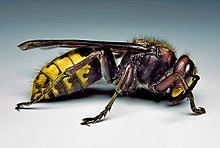You can help expand this article with text translated from the corresponding article in Japanese. (June 2018) Click for important translation instructions.
|
| Vespinae Temporal range: Thanetian–Recent PreꞒ Ꞓ O S D C P T J K Pg N | |
|---|---|

| |
| European hornet, Vespa crabro | |
| Scientific classification | |
| Domain: | Eukaryota |
| Kingdom: | Animalia |
| Phylum: | Arthropoda |
| Class: | Insecta |
| Order: | Hymenoptera |
| Family: | Vespidae |
| Subfamily: | Vespinae Latreille, 1802 |
| Genera | |
The subfamily Vespinae contains the largest and best-known groups of eusocial wasps, including true hornets (the genus Vespa), and the "yellowjackets" (genera Dolichovespula and Vespula). The remaining genus, Provespa, is a small, poorly known group of nocturnal wasps from Southeast Asia. One genus, Palaeovespa, has been described the Paleocene to Eocene fossil records of North America and Europe. Collectively, the group can be found on all continents except Antarctica, and several of these wasps are invasive species, introduced beyond their native ranges, and can be major pests.

References
- Jm, Carpenter (1997). "Checklist of the species in the subfamily Vespinae (Insecta : Hymenoptera : Vespidae)". Nat Hist Bull Ibaraki Univ. 1: 51–92.
- Yamane, Seiki; Yamane, Sôichi (2021). Starr, Christopher K. (ed.). Vespinae. Cham: Springer International Publishing. pp. 1000–1008. doi:10.1007/978-3-030-28102-1_133. ISBN 978-3-030-28101-4. Retrieved 2023-06-12.
{{cite book}}:|work=ignored (help)
| Taxon identifiers | |
|---|---|
| Vespinae | |
This Vespidae-related article is a stub. You can help Misplaced Pages by expanding it. |